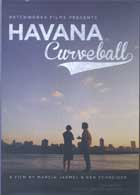
Havana Curveball 2014
Distributed by Patchwork Films, via ScreenHouse Media, 64 Hummel Road, New Paltz, NY 12561; 800-880-3129
Produced by Marcia Jarmel and Ken Schneider
Produced by Marcia Jarmel and Ken Schneider
DVD , color, 60 min.
Sr. High - General Adult
Adolescence, Jewish Studies
Date Entered: 08/21/2014
Reviewed by Mary Northrup, Metropolitan Community College-Maple Woods, Kansas City, MissouriThis affecting story about a young teen who wanted to change the world will appeal to many. Mica, thirteen when the story starts and sixteen when it ends, loves baseball. For a synagogue project, he wants to pay back the people of Cuba who took in his grandfather as a boy in pre-World War II years when the family could not get into the United States. He discovers the difficulties in sending baseball equipment to Cuba, and finally decides that he wants to make the trip himself.
The film, directed and produced by Mica’s parents, show him in a variety of settings, including talking to the camera. At school, at his bar mitzvah, at the computer, playing baseball, the story is told as he decides on his project and as it develops. The length of time is shown by labeling his ages – 13, 14, 15 – as the film progresses. This helps, as well as the narrative, to show the long-term aspect of the project.
The cinematography is beautiful, especially that done in Cuba, with good color and composition. Background music ranges from klezmer to folk rock, which blends in and adds to the mood. Subtitles appear when Spanish is spoken.
The filmmakers capture Mica as a teen with an idea, and his trip to Cuba is rewarding for the viewer, too. Especially emotional are scenes where he goes to a synagogue in Cuba and when he finds the house that his grandfather lived in as a small boy. There is plenty of baseball, too, as Mica is invited to play with a youth team and as he attends a pro ball game. The difficulty of visiting Cuba comes through clearly, as well as some of the political problems, especially trade with Cuba.
The film would make a good discussion piece for teenagers of any religion in church or synagogue groups, for high school classes studying Cuba, for budding filmmakers as a fine example of filming a memoir, or for any who are interested in the story of a close family and a boy with an idea.